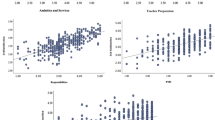Abstract
Research on work life and job satisfaction of university professors is becoming an important research issue in the field of higher education. This study used questionnaires administered to 1 770 teachers from different levels, types, and academic fields of Chinese universities to investigate job satisfaction among university professors and the relationship between job satisfaction of university professors and the organizational characteristics of the university. The job satisfaction of Chinese university professors includes six dimensions: career development and school management, teaching and research services, salary, benefits and logistical services, professional reputation, teaching and research facilities, and the work itself. The overall job satisfaction levels are close to average, with salary and benefits receiving the lowest level of satisfaction. The organizational characteristics of universities, such as school type, school level, academic field, organizational climate, evaluation orientation, and school management, all have significant effects on the overall job satisfaction of university professors. The organizational climate and school level affect all six dimensions of job satisfaction among university professors.
Similar content being viewed by others
References
Altbach, G. P., & Umakoshi, T. (2004). Asian universities: Historical perspectives and contemporary challenges. Baltimore: The John Hopkins University Press.
Aquirre, Je. A. (2000). Women and minority faculty in the academic workplace: Recruitment, retention, and academic culture. ASHE-ERIC Higher Education Report, 27(6), San Francisco, CA: Jossey-Bass.
Boyer, E., Altbach, P., & Whitelaw, M. J. (1994). The academic profession: An international perspective. New Jersey, The Carnegie Foundation for the Advancement of Teaching.
Grunwald, H., & Peterson, M. W. (2003). Factors that promote faculty involvement in and satisfaction with institutional and classroom student assessment. Research in Higher Education, 44(2), 173–204.
Hagedorn, L. S. (1996). Wage equity and female faculty job satisfaction: The role of wage differentials in a job satisfaction casual model. Research in Higher Education, 37(5), 569–598.
Hagedorn, L. S. (2000). Conceptualizing faculty job satisfaction: Components, theories, and outcomes. New Directions for Institutional Research, 27(1), 5–20.
He, G-m. & Yao, L-m. (2009). The comment on the study of teachers’ job satisfaction. University Education Science, (1), 38.
Herzberg, F., Mausner, B., & Synderman, B. B. (1999). The motivation to work (3rd ed.) (pp. 85–92). Transaction Publishers New Brunswick, New Jersey.
Hoppock, R. (1935). Job satisfaction (pp. 8–21). New York: Harper & Brothers Publishers.
Hsu, C-K. (1977). Determinants and correlates of Chinese workers’ job satisfaction. Bulletin of the Institute of Ethnology, Academia Sinica, (43), 23–63.
Johnsrud, L. K., & Sadao, K. C. (1998). The common experience of “otherness”: Ethnic and racial minority faculty. The Review of Higher Education, 21(4), 315–342
Johnsrud, L. K., & Rosser, V. J. (2002). Faculty members’ morale and their intentions to leave: A multilevel explanation. The Journal of Higher Education, 71(1), 34–59.
Lacy, F. J., & Sheehan, B. A. (1997). Job satisfaction among academic staff: An international perspective. Higher Education, 34(3), 305–322.
Lai, M. (2006). Challenges faced by academics in the Chinese mainland and their responses. Paper presented at the Annual Conference of the Canadian Society for the Study of Education on “Mapping the Educational Landscape: Diversity, Democracy and the Future,” York University, Toronto, Canada.
Lai, M., & Lo, N. K. L. (2007). The changing work lives of academics: The experience of a regional university on the Chinese Mainland. Higher Education Policy, 20(2), 145–167.
Liu, G. (2006). Survey of job satisfaction of university teachers—empirical study on teachers in one university. Bulletin of Hunan University (social sciences edition), (4), 68–73.
Locke, E. A. (1976). The nature and causes of job satisfaction. In M. D. Dunnette (Ed.), Handbook of industrial and organizational psychology (pp.1297–1349), Chicago, IL, Rand McNally.
Magner, D. K. (September 3, 1999). The graying professoriate. Chronicle of Higher Education, A18.
Mapesela, M., & Hay, H. D. (2006). The effect of change and transformation on academic staff and job satisfaction: A case of a South African university. Higher Education, 52(4), 711–747.
Matier, M. W. (1990). Retaining faculty: A tale of two campuses. Research in Higher Education, 31(1), 39–60.
Oshagbemi, T. (1996). Job satisfaction of UK academics. Educational Management and Administration, 24(4), 389–400.
Pearson, D. A., & Seiler, R. E. (1983). Environmental satisfiers in academe. Higher Education, 12(1), 35–47.
Porter, et al. (1973). Organizational work and personal factors in employee turn-over and absenteeism. Psychological Bulletin, (50), 151–176.
Rice, E. R., & Austin, A. E. (1988). Faculty morale: What exemplary colleges do right. Change, 20(3), 51–58.
Rosser, J. V. (2004). Faculty members’ intentions to leave: A national study on their work life and satisfaction. Research in Higher Education, (3), 285–309.
Sabharwal, M., & Corley, E. A. (2009). Faculty job satisfaction across gender and discipline. The Social Science Journal, 46, 539–556.
Smart, C. J. (1990). A casual model of faculty turnover intentions. Research in Higher Education, 31(5), 405–424.
Ssesanga, K. & Garrett, M. R. (2005). Job satisfaction of university academics: Perspectives from Uganda. Higher Education, 50(1), 33–56.
Yuan, L., Xie, C. & Xie, F-s (2006). An investigation and analysis of the teachers’ job satisfaction in higher education. Journal of Educational Science of Hunan Normal University, (3), 103–106.
Zhao, L., Zhu, Z., & Zuo, H. (2007) Survey of job satisfaction of local university. Contemporary Economics, (6), 61–62.
Author information
Authors and Affiliations
Corresponding author
Rights and permissions
About this article
Cite this article
Du, P., Lai, M. & Lo, L.N.K. Analysis of job satisfaction of university professors from nine Chinese universities. Front. Educ. China 5, 430–449 (2010). https://doi.org/10.1007/s11516-010-0109-8
Received:
Published:
Issue Date:
DOI: https://doi.org/10.1007/s11516-010-0109-8




